Comparative Economic Study: Germany and Turkey - Economics Report
VerifiedAdded on 2022/09/13
|12
|2726
|14
Report
AI Summary
This report undertakes a comparative economic study between Germany and Turkey, examining the relationship between economic growth and the standard of living in both countries. The analysis begins with an examination of their respective economic growth trajectories, focusing on GDP growth rates over the past decade, including the impact of the global financial crisis and the key sectors driving their economies. The report then delves into the standards of living in each country, utilizing various indicators such as GDP per capita, income inequality (Gini Index), poverty rates, unemployment figures, Human Development Index (HDI), Inequality-adjusted HDI, and the Social Progress Index (SPI). A comprehensive comparison of these economic and social welfare metrics reveals that while Turkey exhibits higher GDP growth, Germany demonstrates a superior standard of living. The report concludes by discussing the implications of economic growth on living standards, emphasizing the importance of inclusive economic growth for improved social well-being, suggesting that economic growth does not necessarily equate to higher living standards. The report recommends considering a broader range of factors beyond GDP growth to understand the true level of living standards.
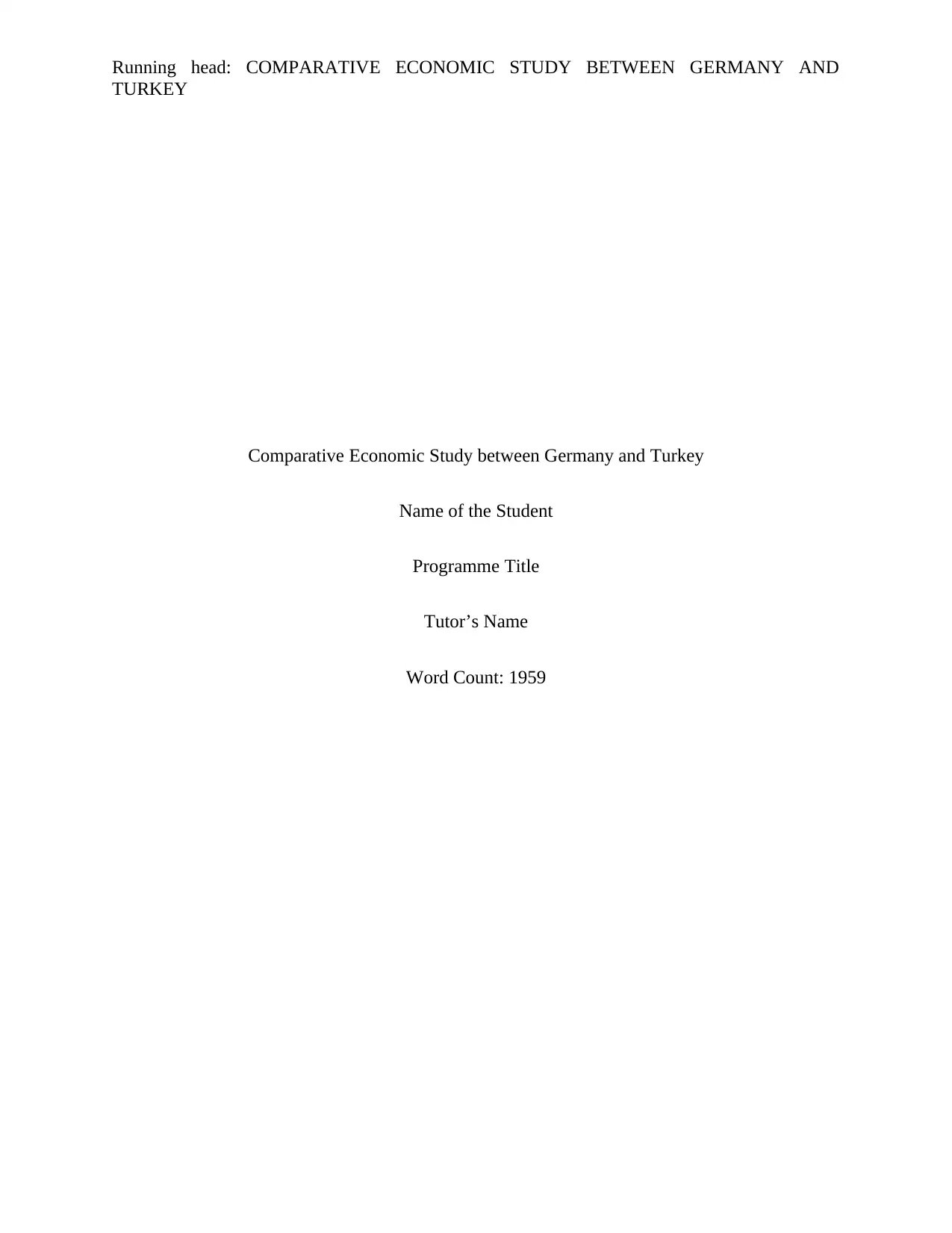
Running head: COMPARATIVE ECONOMIC STUDY BETWEEN GERMANY AND
TURKEY
Comparative Economic Study between Germany and Turkey
Name of the Student
Programme Title
Tutor’s Name
Word Count: 1959
TURKEY
Comparative Economic Study between Germany and Turkey
Name of the Student
Programme Title
Tutor’s Name
Word Count: 1959
Paraphrase This Document
Need a fresh take? Get an instant paraphrase of this document with our AI Paraphraser
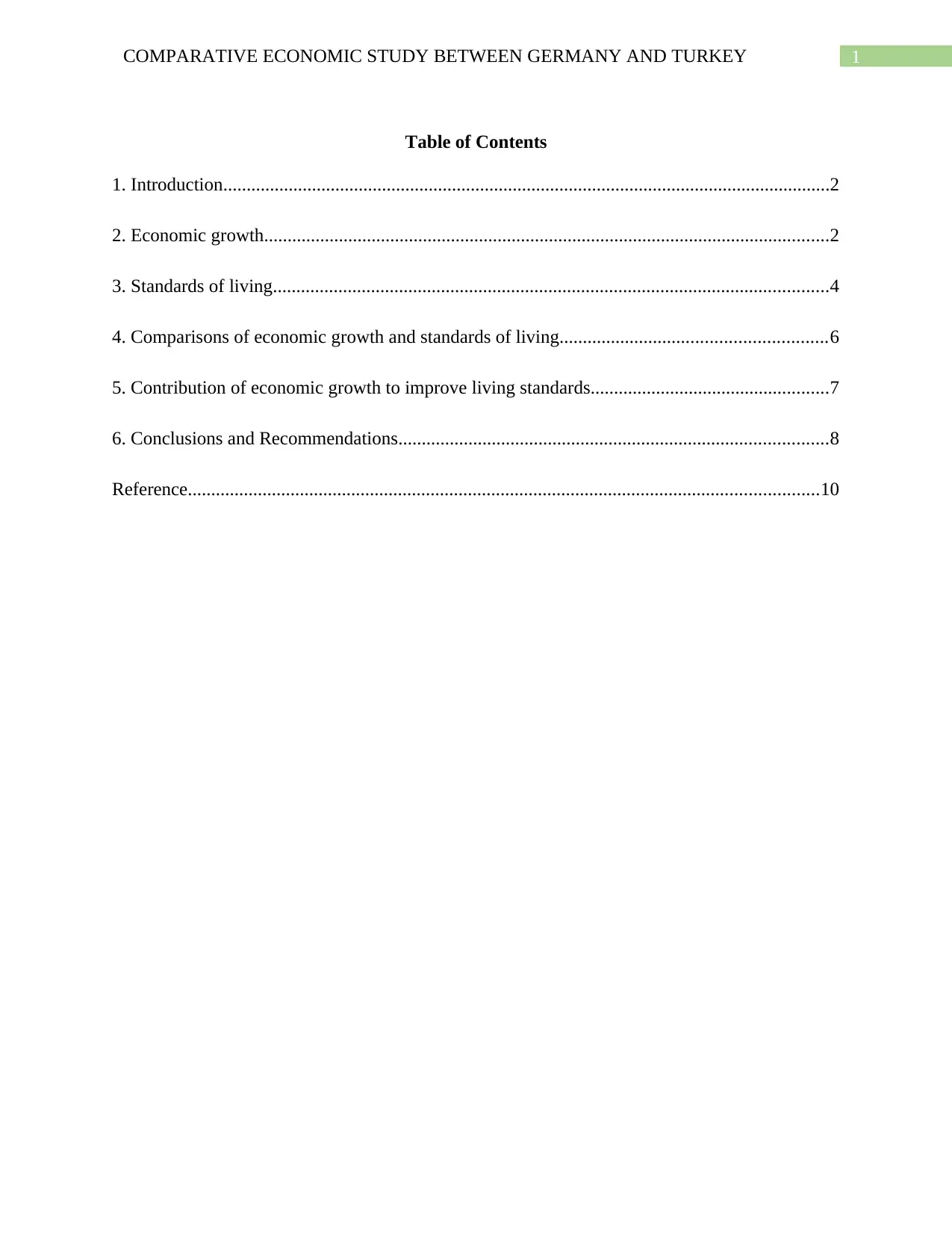
1COMPARATIVE ECONOMIC STUDY BETWEEN GERMANY AND TURKEY
Table of Contents
1. Introduction..................................................................................................................................2
2. Economic growth.........................................................................................................................2
3. Standards of living.......................................................................................................................4
4. Comparisons of economic growth and standards of living.........................................................6
5. Contribution of economic growth to improve living standards...................................................7
6. Conclusions and Recommendations............................................................................................8
Reference.......................................................................................................................................10
Table of Contents
1. Introduction..................................................................................................................................2
2. Economic growth.........................................................................................................................2
3. Standards of living.......................................................................................................................4
4. Comparisons of economic growth and standards of living.........................................................6
5. Contribution of economic growth to improve living standards...................................................7
6. Conclusions and Recommendations............................................................................................8
Reference.......................................................................................................................................10
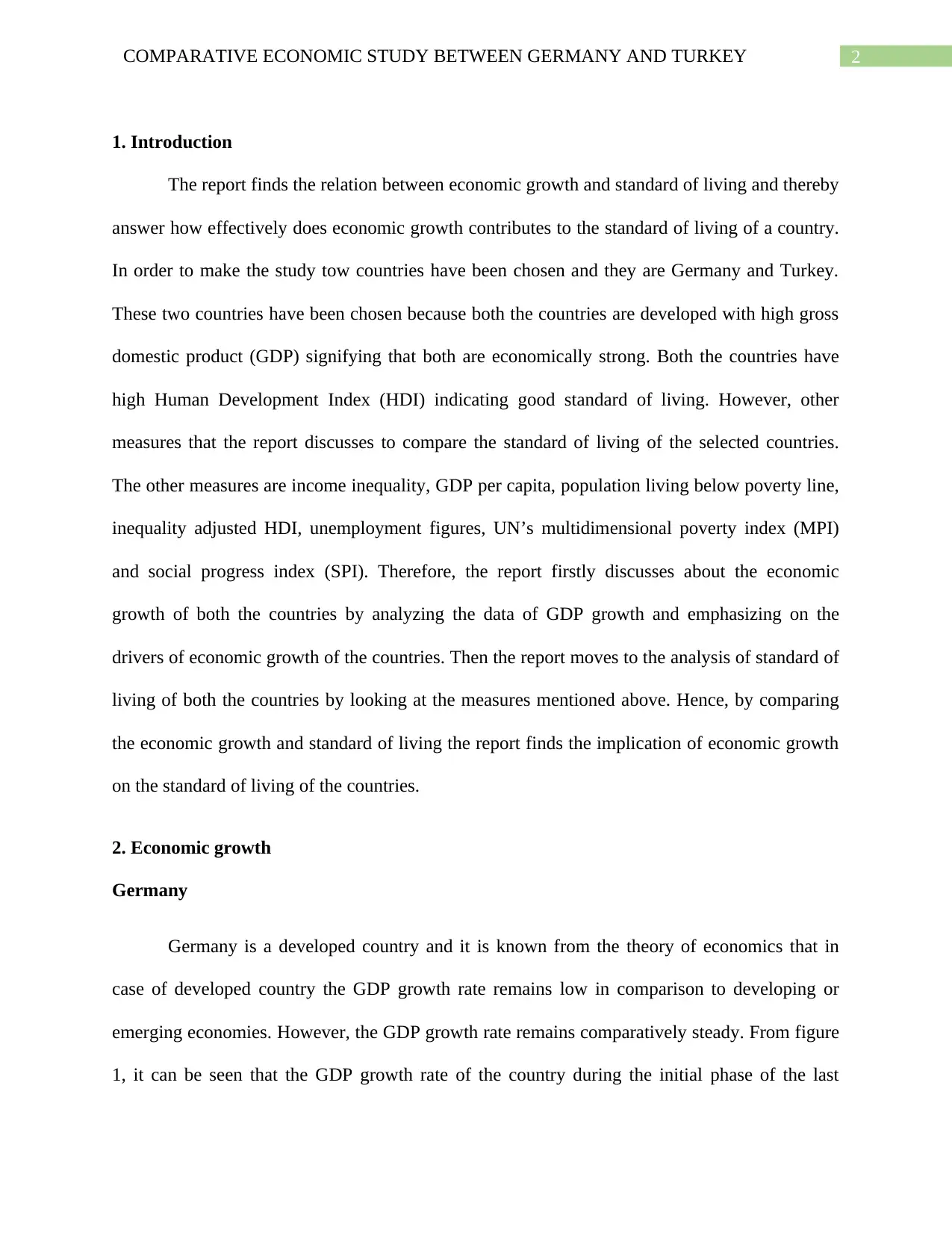
2COMPARATIVE ECONOMIC STUDY BETWEEN GERMANY AND TURKEY
1. Introduction
The report finds the relation between economic growth and standard of living and thereby
answer how effectively does economic growth contributes to the standard of living of a country.
In order to make the study tow countries have been chosen and they are Germany and Turkey.
These two countries have been chosen because both the countries are developed with high gross
domestic product (GDP) signifying that both are economically strong. Both the countries have
high Human Development Index (HDI) indicating good standard of living. However, other
measures that the report discusses to compare the standard of living of the selected countries.
The other measures are income inequality, GDP per capita, population living below poverty line,
inequality adjusted HDI, unemployment figures, UN’s multidimensional poverty index (MPI)
and social progress index (SPI). Therefore, the report firstly discusses about the economic
growth of both the countries by analyzing the data of GDP growth and emphasizing on the
drivers of economic growth of the countries. Then the report moves to the analysis of standard of
living of both the countries by looking at the measures mentioned above. Hence, by comparing
the economic growth and standard of living the report finds the implication of economic growth
on the standard of living of the countries.
2. Economic growth
Germany
Germany is a developed country and it is known from the theory of economics that in
case of developed country the GDP growth rate remains low in comparison to developing or
emerging economies. However, the GDP growth rate remains comparatively steady. From figure
1, it can be seen that the GDP growth rate of the country during the initial phase of the last
1. Introduction
The report finds the relation between economic growth and standard of living and thereby
answer how effectively does economic growth contributes to the standard of living of a country.
In order to make the study tow countries have been chosen and they are Germany and Turkey.
These two countries have been chosen because both the countries are developed with high gross
domestic product (GDP) signifying that both are economically strong. Both the countries have
high Human Development Index (HDI) indicating good standard of living. However, other
measures that the report discusses to compare the standard of living of the selected countries.
The other measures are income inequality, GDP per capita, population living below poverty line,
inequality adjusted HDI, unemployment figures, UN’s multidimensional poverty index (MPI)
and social progress index (SPI). Therefore, the report firstly discusses about the economic
growth of both the countries by analyzing the data of GDP growth and emphasizing on the
drivers of economic growth of the countries. Then the report moves to the analysis of standard of
living of both the countries by looking at the measures mentioned above. Hence, by comparing
the economic growth and standard of living the report finds the implication of economic growth
on the standard of living of the countries.
2. Economic growth
Germany
Germany is a developed country and it is known from the theory of economics that in
case of developed country the GDP growth rate remains low in comparison to developing or
emerging economies. However, the GDP growth rate remains comparatively steady. From figure
1, it can be seen that the GDP growth rate of the country during the initial phase of the last
⊘ This is a preview!⊘
Do you want full access?
Subscribe today to unlock all pages.

Trusted by 1+ million students worldwide
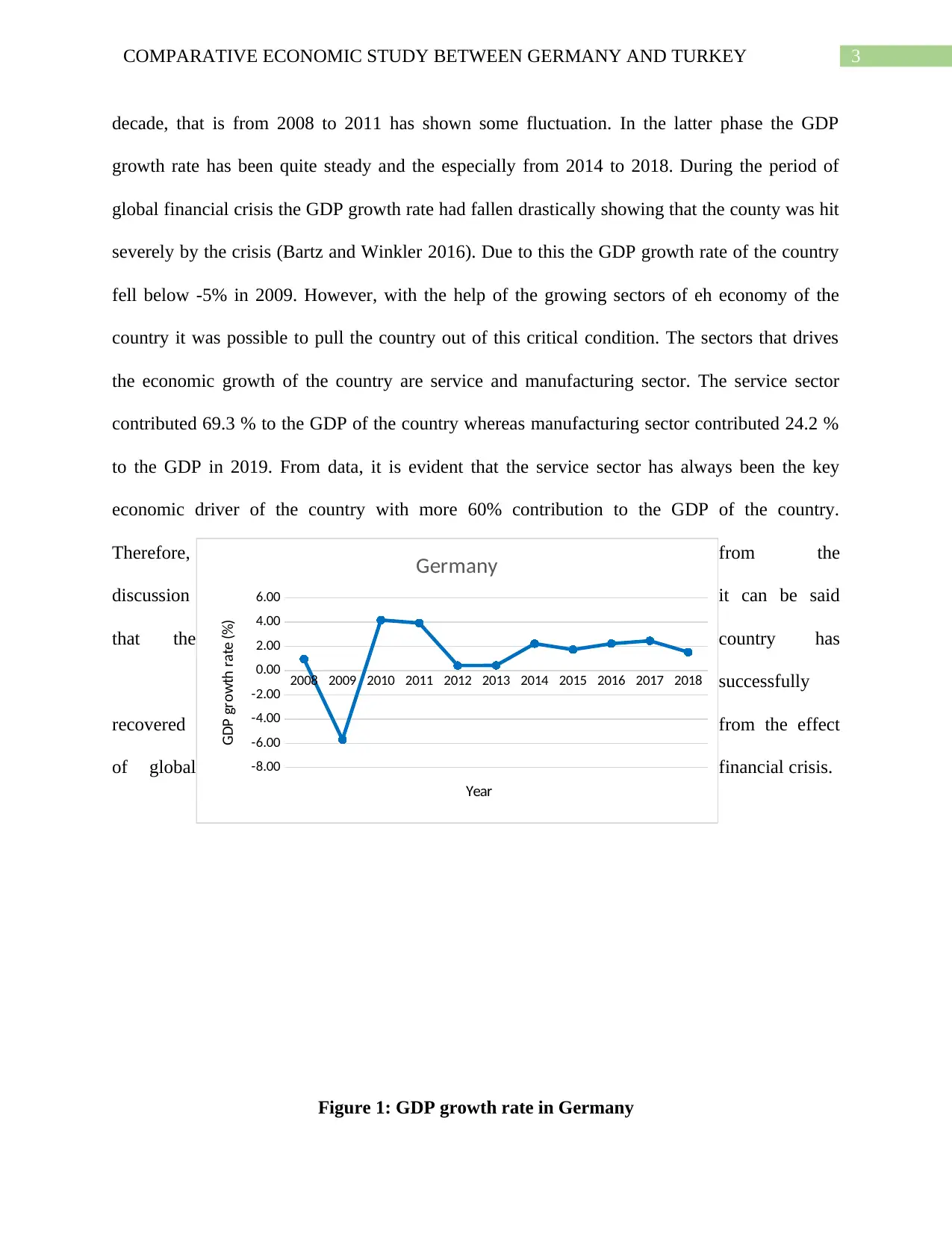
3COMPARATIVE ECONOMIC STUDY BETWEEN GERMANY AND TURKEY
decade, that is from 2008 to 2011 has shown some fluctuation. In the latter phase the GDP
growth rate has been quite steady and the especially from 2014 to 2018. During the period of
global financial crisis the GDP growth rate had fallen drastically showing that the county was hit
severely by the crisis (Bartz and Winkler 2016). Due to this the GDP growth rate of the country
fell below -5% in 2009. However, with the help of the growing sectors of eh economy of the
country it was possible to pull the country out of this critical condition. The sectors that drives
the economic growth of the country are service and manufacturing sector. The service sector
contributed 69.3 % to the GDP of the country whereas manufacturing sector contributed 24.2 %
to the GDP in 2019. From data, it is evident that the service sector has always been the key
economic driver of the country with more 60% contribution to the GDP of the country.
Therefore, from the
discussion it can be said
that the country has
successfully
recovered from the effect
of global financial crisis.
Figure 1: GDP growth rate in Germany
2008 2009 2010 2011 2012 2013 2014 2015 2016 2017 2018
-8.00
-6.00
-4.00
-2.00
0.00
2.00
4.00
6.00
Germany
Year
GDP growth rate (%)
decade, that is from 2008 to 2011 has shown some fluctuation. In the latter phase the GDP
growth rate has been quite steady and the especially from 2014 to 2018. During the period of
global financial crisis the GDP growth rate had fallen drastically showing that the county was hit
severely by the crisis (Bartz and Winkler 2016). Due to this the GDP growth rate of the country
fell below -5% in 2009. However, with the help of the growing sectors of eh economy of the
country it was possible to pull the country out of this critical condition. The sectors that drives
the economic growth of the country are service and manufacturing sector. The service sector
contributed 69.3 % to the GDP of the country whereas manufacturing sector contributed 24.2 %
to the GDP in 2019. From data, it is evident that the service sector has always been the key
economic driver of the country with more 60% contribution to the GDP of the country.
Therefore, from the
discussion it can be said
that the country has
successfully
recovered from the effect
of global financial crisis.
Figure 1: GDP growth rate in Germany
2008 2009 2010 2011 2012 2013 2014 2015 2016 2017 2018
-8.00
-6.00
-4.00
-2.00
0.00
2.00
4.00
6.00
Germany
Year
GDP growth rate (%)
Paraphrase This Document
Need a fresh take? Get an instant paraphrase of this document with our AI Paraphraser
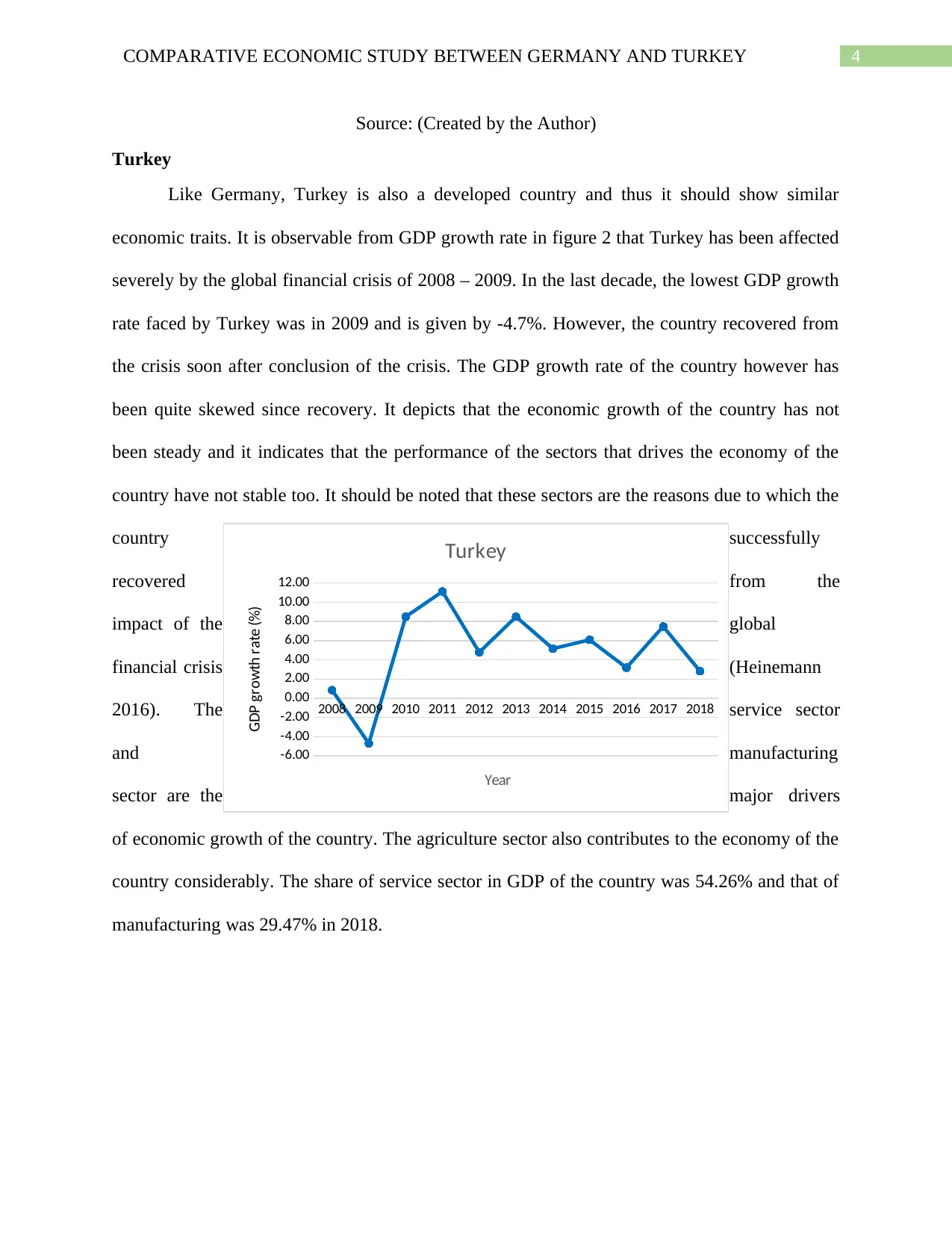
4COMPARATIVE ECONOMIC STUDY BETWEEN GERMANY AND TURKEY
Source: (Created by the Author)
Turkey
Like Germany, Turkey is also a developed country and thus it should show similar
economic traits. It is observable from GDP growth rate in figure 2 that Turkey has been affected
severely by the global financial crisis of 2008 – 2009. In the last decade, the lowest GDP growth
rate faced by Turkey was in 2009 and is given by -4.7%. However, the country recovered from
the crisis soon after conclusion of the crisis. The GDP growth rate of the country however has
been quite skewed since recovery. It depicts that the economic growth of the country has not
been steady and it indicates that the performance of the sectors that drives the economy of the
country have not stable too. It should be noted that these sectors are the reasons due to which the
country successfully
recovered from the
impact of the global
financial crisis (Heinemann
2016). The service sector
and manufacturing
sector are the major drivers
of economic growth of the country. The agriculture sector also contributes to the economy of the
country considerably. The share of service sector in GDP of the country was 54.26% and that of
manufacturing was 29.47% in 2018.
2008 2009 2010 2011 2012 2013 2014 2015 2016 2017 2018
-6.00
-4.00
-2.00
0.00
2.00
4.00
6.00
8.00
10.00
12.00
Turkey
Year
GDP growth rate (%)
Source: (Created by the Author)
Turkey
Like Germany, Turkey is also a developed country and thus it should show similar
economic traits. It is observable from GDP growth rate in figure 2 that Turkey has been affected
severely by the global financial crisis of 2008 – 2009. In the last decade, the lowest GDP growth
rate faced by Turkey was in 2009 and is given by -4.7%. However, the country recovered from
the crisis soon after conclusion of the crisis. The GDP growth rate of the country however has
been quite skewed since recovery. It depicts that the economic growth of the country has not
been steady and it indicates that the performance of the sectors that drives the economy of the
country have not stable too. It should be noted that these sectors are the reasons due to which the
country successfully
recovered from the
impact of the global
financial crisis (Heinemann
2016). The service sector
and manufacturing
sector are the major drivers
of economic growth of the country. The agriculture sector also contributes to the economy of the
country considerably. The share of service sector in GDP of the country was 54.26% and that of
manufacturing was 29.47% in 2018.
2008 2009 2010 2011 2012 2013 2014 2015 2016 2017 2018
-6.00
-4.00
-2.00
0.00
2.00
4.00
6.00
8.00
10.00
12.00
Turkey
Year
GDP growth rate (%)
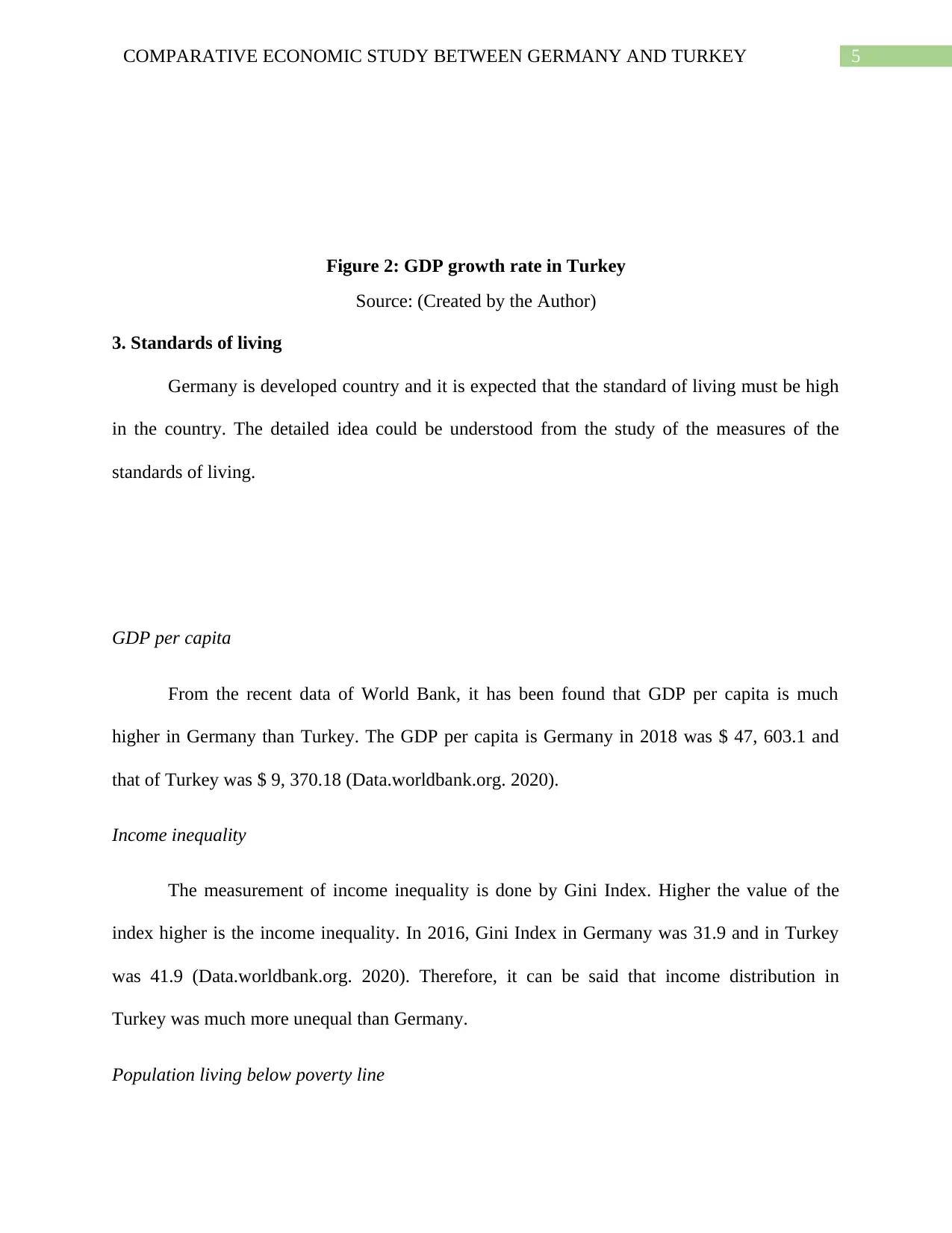
5COMPARATIVE ECONOMIC STUDY BETWEEN GERMANY AND TURKEY
Figure 2: GDP growth rate in Turkey
Source: (Created by the Author)
3. Standards of living
Germany is developed country and it is expected that the standard of living must be high
in the country. The detailed idea could be understood from the study of the measures of the
standards of living.
GDP per capita
From the recent data of World Bank, it has been found that GDP per capita is much
higher in Germany than Turkey. The GDP per capita is Germany in 2018 was $ 47, 603.1 and
that of Turkey was $ 9, 370.18 (Data.worldbank.org. 2020).
Income inequality
The measurement of income inequality is done by Gini Index. Higher the value of the
index higher is the income inequality. In 2016, Gini Index in Germany was 31.9 and in Turkey
was 41.9 (Data.worldbank.org. 2020). Therefore, it can be said that income distribution in
Turkey was much more unequal than Germany.
Population living below poverty line
Figure 2: GDP growth rate in Turkey
Source: (Created by the Author)
3. Standards of living
Germany is developed country and it is expected that the standard of living must be high
in the country. The detailed idea could be understood from the study of the measures of the
standards of living.
GDP per capita
From the recent data of World Bank, it has been found that GDP per capita is much
higher in Germany than Turkey. The GDP per capita is Germany in 2018 was $ 47, 603.1 and
that of Turkey was $ 9, 370.18 (Data.worldbank.org. 2020).
Income inequality
The measurement of income inequality is done by Gini Index. Higher the value of the
index higher is the income inequality. In 2016, Gini Index in Germany was 31.9 and in Turkey
was 41.9 (Data.worldbank.org. 2020). Therefore, it can be said that income distribution in
Turkey was much more unequal than Germany.
Population living below poverty line
⊘ This is a preview!⊘
Do you want full access?
Subscribe today to unlock all pages.

Trusted by 1+ million students worldwide
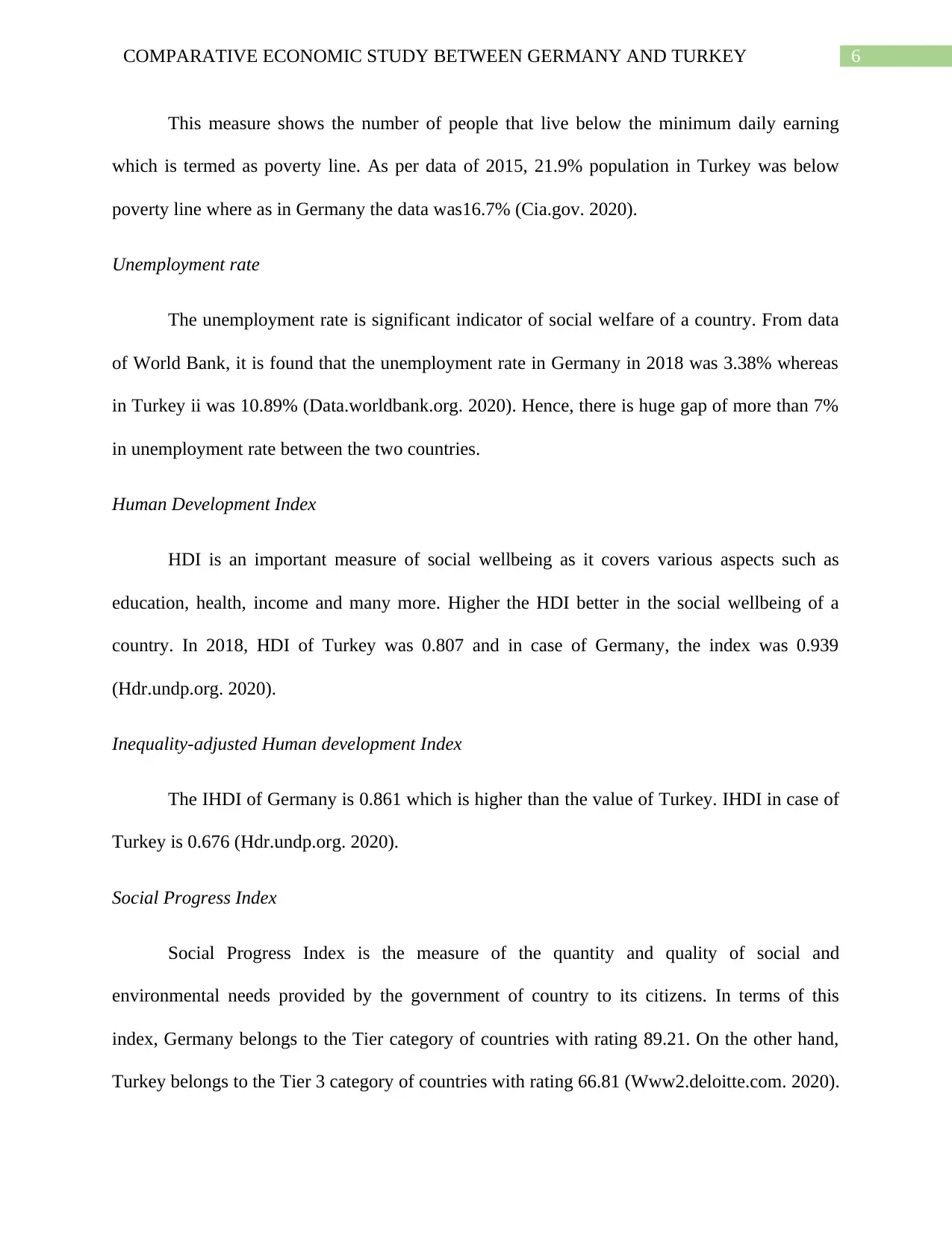
6COMPARATIVE ECONOMIC STUDY BETWEEN GERMANY AND TURKEY
This measure shows the number of people that live below the minimum daily earning
which is termed as poverty line. As per data of 2015, 21.9% population in Turkey was below
poverty line where as in Germany the data was16.7% (Cia.gov. 2020).
Unemployment rate
The unemployment rate is significant indicator of social welfare of a country. From data
of World Bank, it is found that the unemployment rate in Germany in 2018 was 3.38% whereas
in Turkey ii was 10.89% (Data.worldbank.org. 2020). Hence, there is huge gap of more than 7%
in unemployment rate between the two countries.
Human Development Index
HDI is an important measure of social wellbeing as it covers various aspects such as
education, health, income and many more. Higher the HDI better in the social wellbeing of a
country. In 2018, HDI of Turkey was 0.807 and in case of Germany, the index was 0.939
(Hdr.undp.org. 2020).
Inequality-adjusted Human development Index
The IHDI of Germany is 0.861 which is higher than the value of Turkey. IHDI in case of
Turkey is 0.676 (Hdr.undp.org. 2020).
Social Progress Index
Social Progress Index is the measure of the quantity and quality of social and
environmental needs provided by the government of country to its citizens. In terms of this
index, Germany belongs to the Tier category of countries with rating 89.21. On the other hand,
Turkey belongs to the Tier 3 category of countries with rating 66.81 (Www2.deloitte.com. 2020).
This measure shows the number of people that live below the minimum daily earning
which is termed as poverty line. As per data of 2015, 21.9% population in Turkey was below
poverty line where as in Germany the data was16.7% (Cia.gov. 2020).
Unemployment rate
The unemployment rate is significant indicator of social welfare of a country. From data
of World Bank, it is found that the unemployment rate in Germany in 2018 was 3.38% whereas
in Turkey ii was 10.89% (Data.worldbank.org. 2020). Hence, there is huge gap of more than 7%
in unemployment rate between the two countries.
Human Development Index
HDI is an important measure of social wellbeing as it covers various aspects such as
education, health, income and many more. Higher the HDI better in the social wellbeing of a
country. In 2018, HDI of Turkey was 0.807 and in case of Germany, the index was 0.939
(Hdr.undp.org. 2020).
Inequality-adjusted Human development Index
The IHDI of Germany is 0.861 which is higher than the value of Turkey. IHDI in case of
Turkey is 0.676 (Hdr.undp.org. 2020).
Social Progress Index
Social Progress Index is the measure of the quantity and quality of social and
environmental needs provided by the government of country to its citizens. In terms of this
index, Germany belongs to the Tier category of countries with rating 89.21. On the other hand,
Turkey belongs to the Tier 3 category of countries with rating 66.81 (Www2.deloitte.com. 2020).
Paraphrase This Document
Need a fresh take? Get an instant paraphrase of this document with our AI Paraphraser
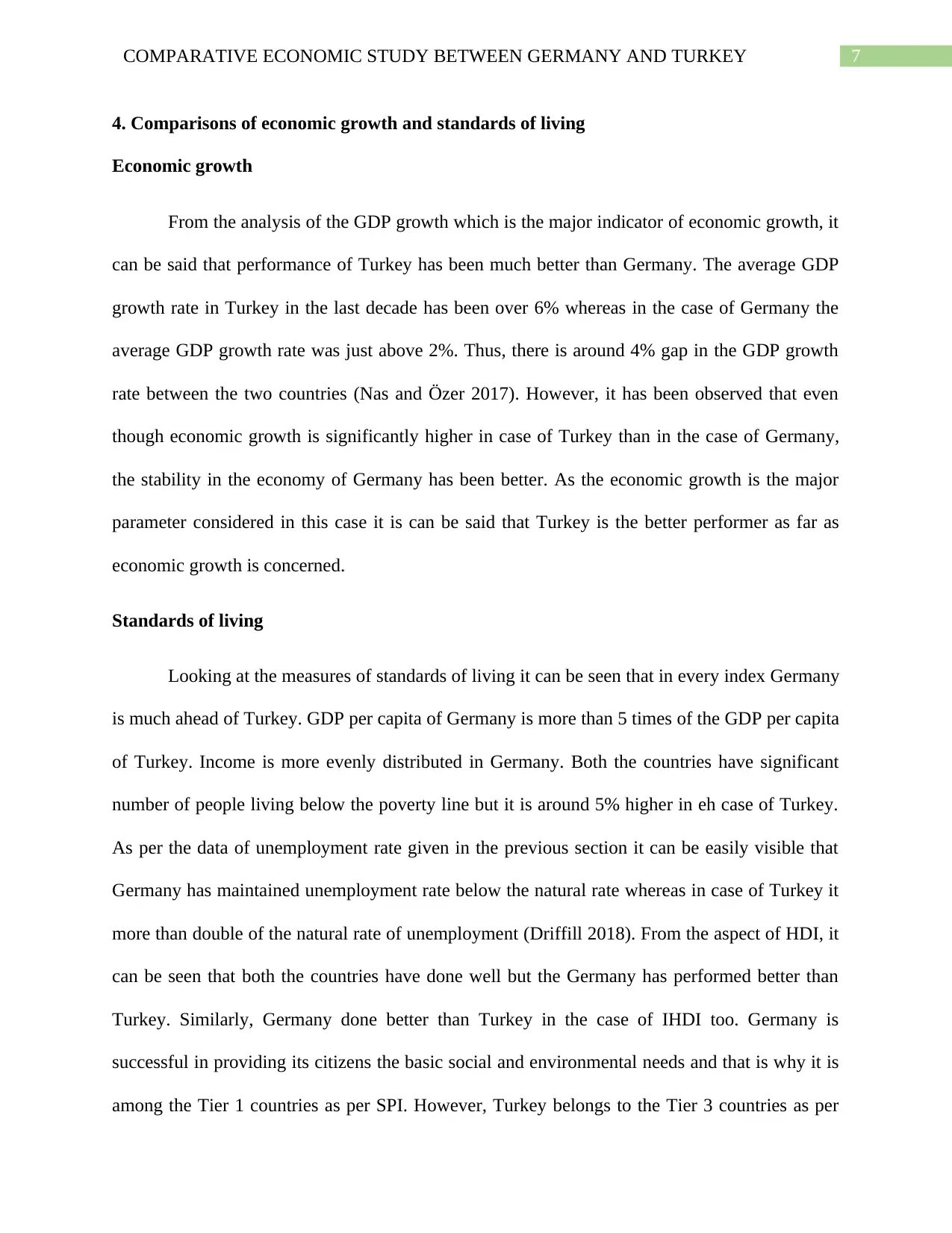
7COMPARATIVE ECONOMIC STUDY BETWEEN GERMANY AND TURKEY
4. Comparisons of economic growth and standards of living
Economic growth
From the analysis of the GDP growth which is the major indicator of economic growth, it
can be said that performance of Turkey has been much better than Germany. The average GDP
growth rate in Turkey in the last decade has been over 6% whereas in the case of Germany the
average GDP growth rate was just above 2%. Thus, there is around 4% gap in the GDP growth
rate between the two countries (Nas and Özer 2017). However, it has been observed that even
though economic growth is significantly higher in case of Turkey than in the case of Germany,
the stability in the economy of Germany has been better. As the economic growth is the major
parameter considered in this case it is can be said that Turkey is the better performer as far as
economic growth is concerned.
Standards of living
Looking at the measures of standards of living it can be seen that in every index Germany
is much ahead of Turkey. GDP per capita of Germany is more than 5 times of the GDP per capita
of Turkey. Income is more evenly distributed in Germany. Both the countries have significant
number of people living below the poverty line but it is around 5% higher in eh case of Turkey.
As per the data of unemployment rate given in the previous section it can be easily visible that
Germany has maintained unemployment rate below the natural rate whereas in case of Turkey it
more than double of the natural rate of unemployment (Driffill 2018). From the aspect of HDI, it
can be seen that both the countries have done well but the Germany has performed better than
Turkey. Similarly, Germany done better than Turkey in the case of IHDI too. Germany is
successful in providing its citizens the basic social and environmental needs and that is why it is
among the Tier 1 countries as per SPI. However, Turkey belongs to the Tier 3 countries as per
4. Comparisons of economic growth and standards of living
Economic growth
From the analysis of the GDP growth which is the major indicator of economic growth, it
can be said that performance of Turkey has been much better than Germany. The average GDP
growth rate in Turkey in the last decade has been over 6% whereas in the case of Germany the
average GDP growth rate was just above 2%. Thus, there is around 4% gap in the GDP growth
rate between the two countries (Nas and Özer 2017). However, it has been observed that even
though economic growth is significantly higher in case of Turkey than in the case of Germany,
the stability in the economy of Germany has been better. As the economic growth is the major
parameter considered in this case it is can be said that Turkey is the better performer as far as
economic growth is concerned.
Standards of living
Looking at the measures of standards of living it can be seen that in every index Germany
is much ahead of Turkey. GDP per capita of Germany is more than 5 times of the GDP per capita
of Turkey. Income is more evenly distributed in Germany. Both the countries have significant
number of people living below the poverty line but it is around 5% higher in eh case of Turkey.
As per the data of unemployment rate given in the previous section it can be easily visible that
Germany has maintained unemployment rate below the natural rate whereas in case of Turkey it
more than double of the natural rate of unemployment (Driffill 2018). From the aspect of HDI, it
can be seen that both the countries have done well but the Germany has performed better than
Turkey. Similarly, Germany done better than Turkey in the case of IHDI too. Germany is
successful in providing its citizens the basic social and environmental needs and that is why it is
among the Tier 1 countries as per SPI. However, Turkey belongs to the Tier 3 countries as per
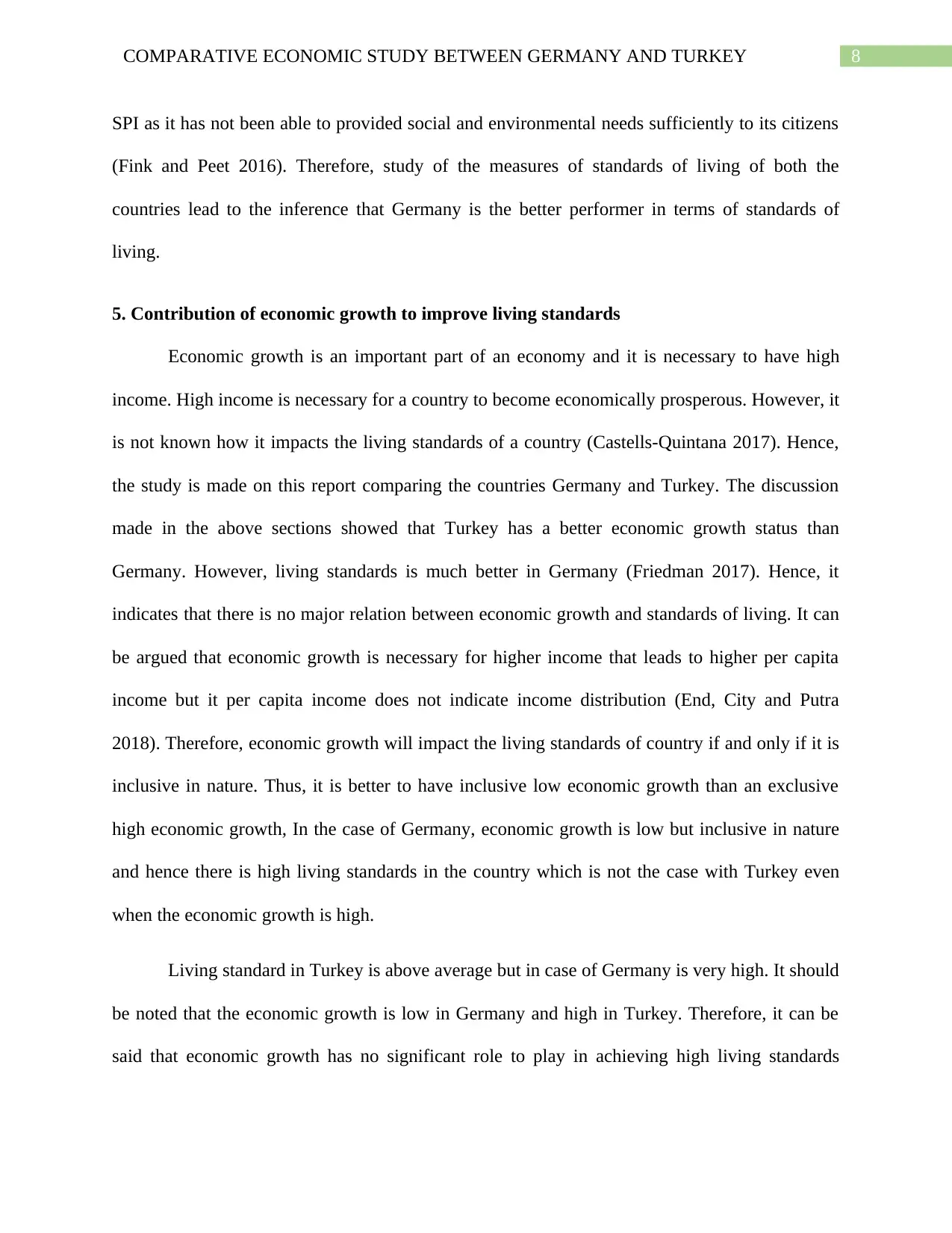
8COMPARATIVE ECONOMIC STUDY BETWEEN GERMANY AND TURKEY
SPI as it has not been able to provided social and environmental needs sufficiently to its citizens
(Fink and Peet 2016). Therefore, study of the measures of standards of living of both the
countries lead to the inference that Germany is the better performer in terms of standards of
living.
5. Contribution of economic growth to improve living standards
Economic growth is an important part of an economy and it is necessary to have high
income. High income is necessary for a country to become economically prosperous. However, it
is not known how it impacts the living standards of a country (Castells-Quintana 2017). Hence,
the study is made on this report comparing the countries Germany and Turkey. The discussion
made in the above sections showed that Turkey has a better economic growth status than
Germany. However, living standards is much better in Germany (Friedman 2017). Hence, it
indicates that there is no major relation between economic growth and standards of living. It can
be argued that economic growth is necessary for higher income that leads to higher per capita
income but it per capita income does not indicate income distribution (End, City and Putra
2018). Therefore, economic growth will impact the living standards of country if and only if it is
inclusive in nature. Thus, it is better to have inclusive low economic growth than an exclusive
high economic growth, In the case of Germany, economic growth is low but inclusive in nature
and hence there is high living standards in the country which is not the case with Turkey even
when the economic growth is high.
Living standard in Turkey is above average but in case of Germany is very high. It should
be noted that the economic growth is low in Germany and high in Turkey. Therefore, it can be
said that economic growth has no significant role to play in achieving high living standards
SPI as it has not been able to provided social and environmental needs sufficiently to its citizens
(Fink and Peet 2016). Therefore, study of the measures of standards of living of both the
countries lead to the inference that Germany is the better performer in terms of standards of
living.
5. Contribution of economic growth to improve living standards
Economic growth is an important part of an economy and it is necessary to have high
income. High income is necessary for a country to become economically prosperous. However, it
is not known how it impacts the living standards of a country (Castells-Quintana 2017). Hence,
the study is made on this report comparing the countries Germany and Turkey. The discussion
made in the above sections showed that Turkey has a better economic growth status than
Germany. However, living standards is much better in Germany (Friedman 2017). Hence, it
indicates that there is no major relation between economic growth and standards of living. It can
be argued that economic growth is necessary for higher income that leads to higher per capita
income but it per capita income does not indicate income distribution (End, City and Putra
2018). Therefore, economic growth will impact the living standards of country if and only if it is
inclusive in nature. Thus, it is better to have inclusive low economic growth than an exclusive
high economic growth, In the case of Germany, economic growth is low but inclusive in nature
and hence there is high living standards in the country which is not the case with Turkey even
when the economic growth is high.
Living standard in Turkey is above average but in case of Germany is very high. It should
be noted that the economic growth is low in Germany and high in Turkey. Therefore, it can be
said that economic growth has no significant role to play in achieving high living standards
⊘ This is a preview!⊘
Do you want full access?
Subscribe today to unlock all pages.

Trusted by 1+ million students worldwide
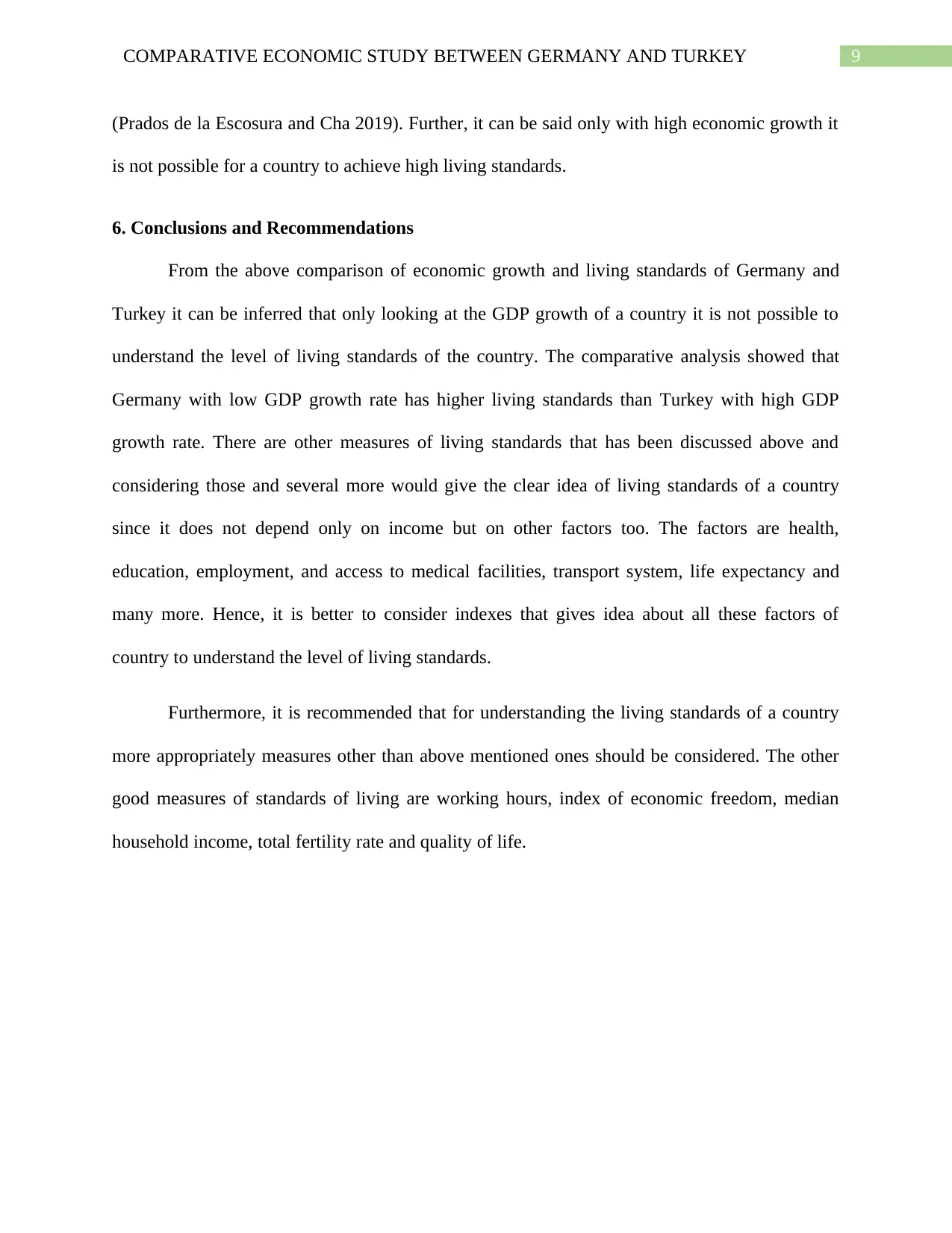
9COMPARATIVE ECONOMIC STUDY BETWEEN GERMANY AND TURKEY
(Prados de la Escosura and Cha 2019). Further, it can be said only with high economic growth it
is not possible for a country to achieve high living standards.
6. Conclusions and Recommendations
From the above comparison of economic growth and living standards of Germany and
Turkey it can be inferred that only looking at the GDP growth of a country it is not possible to
understand the level of living standards of the country. The comparative analysis showed that
Germany with low GDP growth rate has higher living standards than Turkey with high GDP
growth rate. There are other measures of living standards that has been discussed above and
considering those and several more would give the clear idea of living standards of a country
since it does not depend only on income but on other factors too. The factors are health,
education, employment, and access to medical facilities, transport system, life expectancy and
many more. Hence, it is better to consider indexes that gives idea about all these factors of
country to understand the level of living standards.
Furthermore, it is recommended that for understanding the living standards of a country
more appropriately measures other than above mentioned ones should be considered. The other
good measures of standards of living are working hours, index of economic freedom, median
household income, total fertility rate and quality of life.
(Prados de la Escosura and Cha 2019). Further, it can be said only with high economic growth it
is not possible for a country to achieve high living standards.
6. Conclusions and Recommendations
From the above comparison of economic growth and living standards of Germany and
Turkey it can be inferred that only looking at the GDP growth of a country it is not possible to
understand the level of living standards of the country. The comparative analysis showed that
Germany with low GDP growth rate has higher living standards than Turkey with high GDP
growth rate. There are other measures of living standards that has been discussed above and
considering those and several more would give the clear idea of living standards of a country
since it does not depend only on income but on other factors too. The factors are health,
education, employment, and access to medical facilities, transport system, life expectancy and
many more. Hence, it is better to consider indexes that gives idea about all these factors of
country to understand the level of living standards.
Furthermore, it is recommended that for understanding the living standards of a country
more appropriately measures other than above mentioned ones should be considered. The other
good measures of standards of living are working hours, index of economic freedom, median
household income, total fertility rate and quality of life.
Paraphrase This Document
Need a fresh take? Get an instant paraphrase of this document with our AI Paraphraser
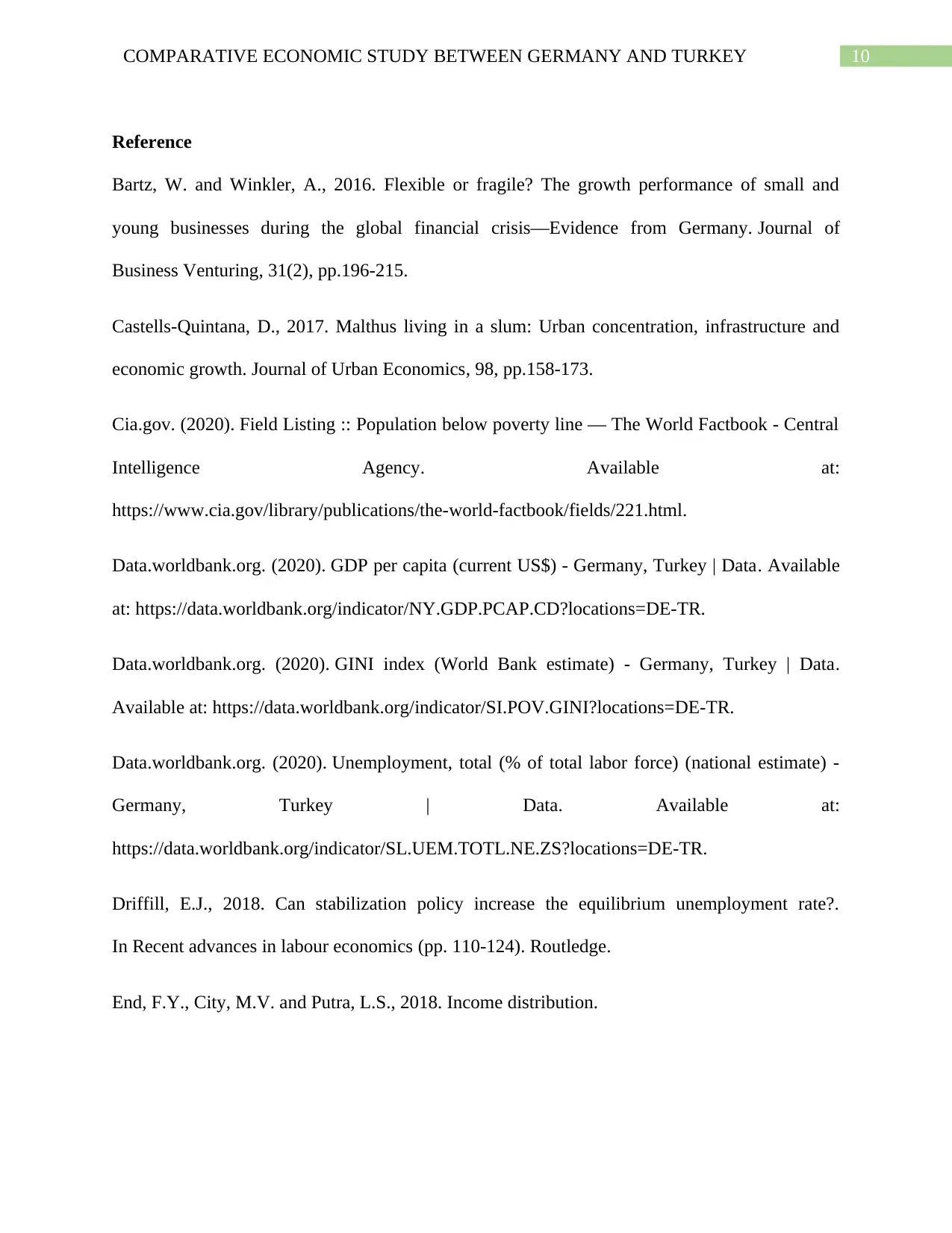
10COMPARATIVE ECONOMIC STUDY BETWEEN GERMANY AND TURKEY
Reference
Bartz, W. and Winkler, A., 2016. Flexible or fragile? The growth performance of small and
young businesses during the global financial crisis—Evidence from Germany. Journal of
Business Venturing, 31(2), pp.196-215.
Castells-Quintana, D., 2017. Malthus living in a slum: Urban concentration, infrastructure and
economic growth. Journal of Urban Economics, 98, pp.158-173.
Cia.gov. (2020). Field Listing :: Population below poverty line — The World Factbook - Central
Intelligence Agency. Available at:
https://www.cia.gov/library/publications/the-world-factbook/fields/221.html.
Data.worldbank.org. (2020). GDP per capita (current US$) - Germany, Turkey | Data. Available
at: https://data.worldbank.org/indicator/NY.GDP.PCAP.CD?locations=DE-TR.
Data.worldbank.org. (2020). GINI index (World Bank estimate) - Germany, Turkey | Data.
Available at: https://data.worldbank.org/indicator/SI.POV.GINI?locations=DE-TR.
Data.worldbank.org. (2020). Unemployment, total (% of total labor force) (national estimate) -
Germany, Turkey | Data. Available at:
https://data.worldbank.org/indicator/SL.UEM.TOTL.NE.ZS?locations=DE-TR.
Driffill, E.J., 2018. Can stabilization policy increase the equilibrium unemployment rate?.
In Recent advances in labour economics (pp. 110-124). Routledge.
End, F.Y., City, M.V. and Putra, L.S., 2018. Income distribution.
Reference
Bartz, W. and Winkler, A., 2016. Flexible or fragile? The growth performance of small and
young businesses during the global financial crisis—Evidence from Germany. Journal of
Business Venturing, 31(2), pp.196-215.
Castells-Quintana, D., 2017. Malthus living in a slum: Urban concentration, infrastructure and
economic growth. Journal of Urban Economics, 98, pp.158-173.
Cia.gov. (2020). Field Listing :: Population below poverty line — The World Factbook - Central
Intelligence Agency. Available at:
https://www.cia.gov/library/publications/the-world-factbook/fields/221.html.
Data.worldbank.org. (2020). GDP per capita (current US$) - Germany, Turkey | Data. Available
at: https://data.worldbank.org/indicator/NY.GDP.PCAP.CD?locations=DE-TR.
Data.worldbank.org. (2020). GINI index (World Bank estimate) - Germany, Turkey | Data.
Available at: https://data.worldbank.org/indicator/SI.POV.GINI?locations=DE-TR.
Data.worldbank.org. (2020). Unemployment, total (% of total labor force) (national estimate) -
Germany, Turkey | Data. Available at:
https://data.worldbank.org/indicator/SL.UEM.TOTL.NE.ZS?locations=DE-TR.
Driffill, E.J., 2018. Can stabilization policy increase the equilibrium unemployment rate?.
In Recent advances in labour economics (pp. 110-124). Routledge.
End, F.Y., City, M.V. and Putra, L.S., 2018. Income distribution.
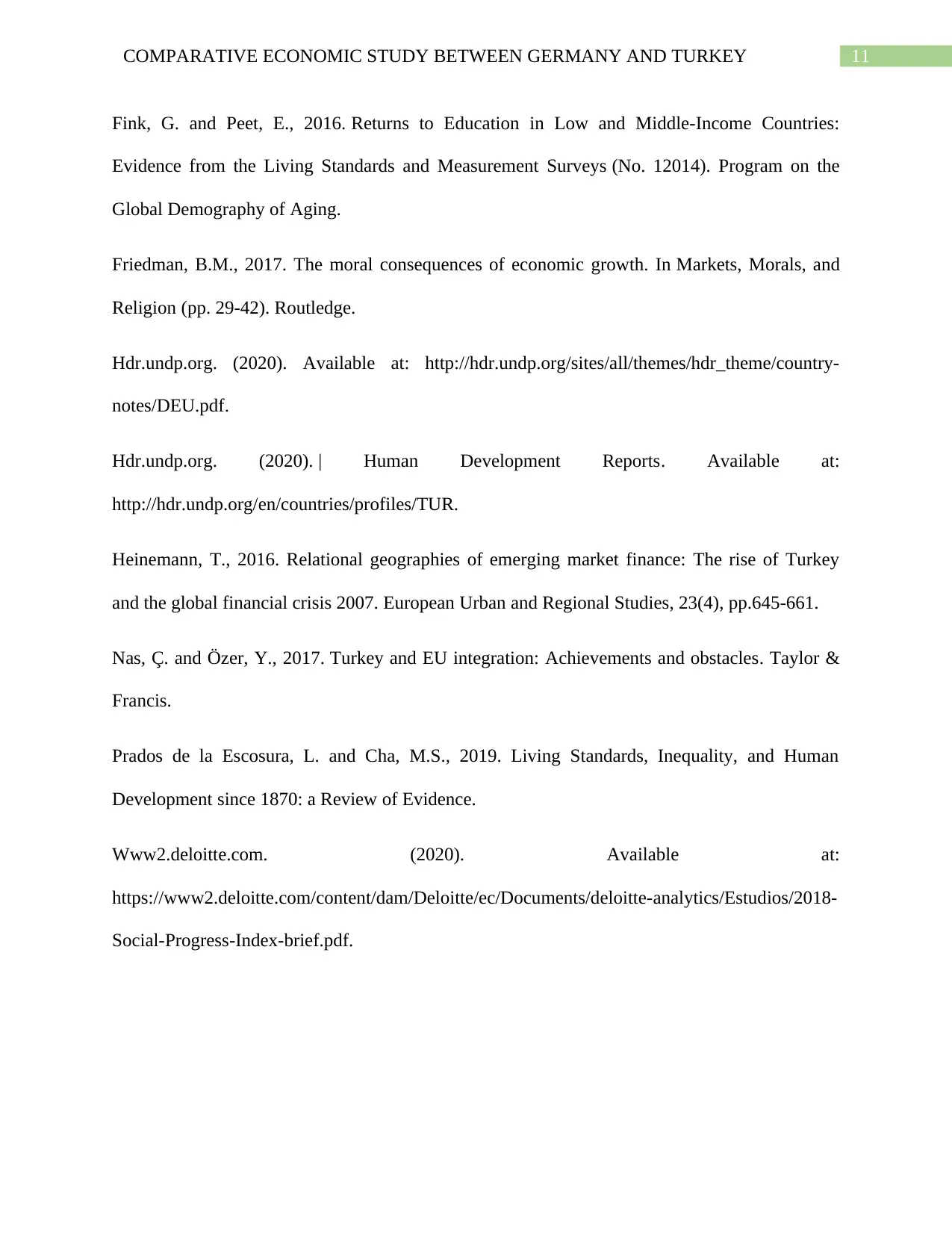
11COMPARATIVE ECONOMIC STUDY BETWEEN GERMANY AND TURKEY
Fink, G. and Peet, E., 2016. Returns to Education in Low and Middle-Income Countries:
Evidence from the Living Standards and Measurement Surveys (No. 12014). Program on the
Global Demography of Aging.
Friedman, B.M., 2017. The moral consequences of economic growth. In Markets, Morals, and
Religion (pp. 29-42). Routledge.
Hdr.undp.org. (2020). Available at: http://hdr.undp.org/sites/all/themes/hdr_theme/country-
notes/DEU.pdf.
Hdr.undp.org. (2020). | Human Development Reports. Available at:
http://hdr.undp.org/en/countries/profiles/TUR.
Heinemann, T., 2016. Relational geographies of emerging market finance: The rise of Turkey
and the global financial crisis 2007. European Urban and Regional Studies, 23(4), pp.645-661.
Nas, Ç. and Özer, Y., 2017. Turkey and EU integration: Achievements and obstacles. Taylor &
Francis.
Prados de la Escosura, L. and Cha, M.S., 2019. Living Standards, Inequality, and Human
Development since 1870: a Review of Evidence.
Www2.deloitte.com. (2020). Available at:
https://www2.deloitte.com/content/dam/Deloitte/ec/Documents/deloitte-analytics/Estudios/2018-
Social-Progress-Index-brief.pdf.
Fink, G. and Peet, E., 2016. Returns to Education in Low and Middle-Income Countries:
Evidence from the Living Standards and Measurement Surveys (No. 12014). Program on the
Global Demography of Aging.
Friedman, B.M., 2017. The moral consequences of economic growth. In Markets, Morals, and
Religion (pp. 29-42). Routledge.
Hdr.undp.org. (2020). Available at: http://hdr.undp.org/sites/all/themes/hdr_theme/country-
notes/DEU.pdf.
Hdr.undp.org. (2020). | Human Development Reports. Available at:
http://hdr.undp.org/en/countries/profiles/TUR.
Heinemann, T., 2016. Relational geographies of emerging market finance: The rise of Turkey
and the global financial crisis 2007. European Urban and Regional Studies, 23(4), pp.645-661.
Nas, Ç. and Özer, Y., 2017. Turkey and EU integration: Achievements and obstacles. Taylor &
Francis.
Prados de la Escosura, L. and Cha, M.S., 2019. Living Standards, Inequality, and Human
Development since 1870: a Review of Evidence.
Www2.deloitte.com. (2020). Available at:
https://www2.deloitte.com/content/dam/Deloitte/ec/Documents/deloitte-analytics/Estudios/2018-
Social-Progress-Index-brief.pdf.
⊘ This is a preview!⊘
Do you want full access?
Subscribe today to unlock all pages.

Trusted by 1+ million students worldwide
1 out of 12
Related Documents
Your All-in-One AI-Powered Toolkit for Academic Success.
+13062052269
info@desklib.com
Available 24*7 on WhatsApp / Email
![[object Object]](/_next/static/media/star-bottom.7253800d.svg)
Unlock your academic potential
Copyright © 2020–2025 A2Z Services. All Rights Reserved. Developed and managed by ZUCOL.





